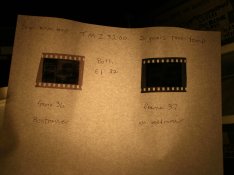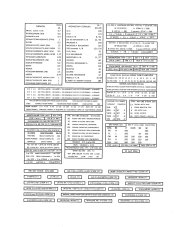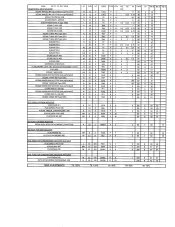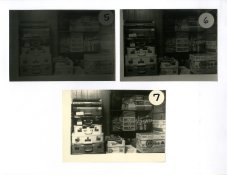David Lyga
Member
I received a query from a subscriber concerning how to process age-fogged films. One need not have to deal with printing through this morass of density, Instead, David Lyga (in his never-ending 'experimentation voyage') has truly saved the day. My methods are decidedly unorthodox, but they do work. You are going to have to learn differently if you want to follow this, as my methods avoid wastage, and my sense of political correctness as to what 'must' be done, is decidedly radical. Read, heed, and you will no further need. - David Lyga
OK, try this, as my method is confusing (even to me) and does change when it seems to get better by changing. For some damn reason the combination of both sodium bicarbonate (henceforth, SB) and Benzotriazole (henceforth, BZ) is synergistic. It really works. To this I now add some serious hydroquinone (Henceforth, HQ) because the one thing that you want with age-fogged materials is contrast.
First, make two solutions and keep them separate. ONLY the HQ solution needs to be kept airtight. Do this (and when I state milliliters (mL) use that, and when I state grams (g) use that. To mix solutions, I use a PET plastic capped bottle and shake vigorously, even for developers. Always.
First, the restrainer solution (henceforth, RS). Take 3.5 g BZ and 30 mL of SB (baking soda). Mix those thoroughly in almost 1000 mL of water, until it becomes a full liter of solution. That is your RS and it does not have to be kept airtight.
Second, make a HQ solution: take 40 mL sodium sulfite, anhy plus 20 mL HQ plus 20 mL sodium carbonate, mono (washing soda) and mix thoroughly in almost 1000 mL of water to make a full liter of solution. This is your HQ solution which MUST be kept completely AIRTIGHT.
Now, what I do is use diluted Dektol as my primary film developer, diluted 1 + 4 (henceforth, 'dev'). So, if you wish to experiment, use clip tests (because you are a damn fool if you use full rolls). Expose about a foot (eight frames) of 35mm film at, say, EI 100 for 1990 Tri-X (of course I do not know how it was stored). Now, I use plastic film cans to process only about one single frame in 10 mL of working solution, so follow me: ALL in mL here: (NOTE: Please understand that even if the film cans are black, the newer ones are not fully light-tight, so I recommend that you do not 'add to the fog' by using them in room light. Process in total darkness. Have the stop and fix ready to reach in the dark. Waste not. All below add up to 10 mL for processing about one frame. Prorate for larger quantities.
This is for moderately fogged film. Here is the formula: 2 dev plus 1 HQ plus 0.5 RS plus 6.5 water
For HEAVILY fogged film, use this: 3 dev plus 3 HQ plus 2 RS plus 2 water. (The extra HQ and RS work to add contrast.)
Other combinations are as follows: (dev / HQ / RS / Water): no fog Tri-X = 3 + 0 + 0 + 7 // light fog: 2.5 + 0.5 + 0.25 + 6.75 // 'impossible fog', especially very bad TMAX 400: 3 + 4 + 3 + 0. This will cure anything but requires about EI 25 or thereabouts.
I work with 80 Fahr temp and the timing is from 6 to 8 minutes. Since 10 mL fills the canister only about halfway, I seal the canister and roll it continuously on its side, back and forth under water, for the full development time in a tempered water bath. (Make sure to press the film against the inner side of the canister so it will be well drenched.) I find the 80 Fahr about ambient, so you probably will not have to do anything to raise or lower the temp, but beware, your hands will tend to increase the temp. A degree or two either way is no disaster.
This is how I work, without wastage, to determine exposure and timing for fogged films. - David Lyga
OK, try this, as my method is confusing (even to me) and does change when it seems to get better by changing. For some damn reason the combination of both sodium bicarbonate (henceforth, SB) and Benzotriazole (henceforth, BZ) is synergistic. It really works. To this I now add some serious hydroquinone (Henceforth, HQ) because the one thing that you want with age-fogged materials is contrast.
First, make two solutions and keep them separate. ONLY the HQ solution needs to be kept airtight. Do this (and when I state milliliters (mL) use that, and when I state grams (g) use that. To mix solutions, I use a PET plastic capped bottle and shake vigorously, even for developers. Always.
First, the restrainer solution (henceforth, RS). Take 3.5 g BZ and 30 mL of SB (baking soda). Mix those thoroughly in almost 1000 mL of water, until it becomes a full liter of solution. That is your RS and it does not have to be kept airtight.
Second, make a HQ solution: take 40 mL sodium sulfite, anhy plus 20 mL HQ plus 20 mL sodium carbonate, mono (washing soda) and mix thoroughly in almost 1000 mL of water to make a full liter of solution. This is your HQ solution which MUST be kept completely AIRTIGHT.
Now, what I do is use diluted Dektol as my primary film developer, diluted 1 + 4 (henceforth, 'dev'). So, if you wish to experiment, use clip tests (because you are a damn fool if you use full rolls). Expose about a foot (eight frames) of 35mm film at, say, EI 100 for 1990 Tri-X (of course I do not know how it was stored). Now, I use plastic film cans to process only about one single frame in 10 mL of working solution, so follow me: ALL in mL here: (NOTE: Please understand that even if the film cans are black, the newer ones are not fully light-tight, so I recommend that you do not 'add to the fog' by using them in room light. Process in total darkness. Have the stop and fix ready to reach in the dark. Waste not. All below add up to 10 mL for processing about one frame. Prorate for larger quantities.
This is for moderately fogged film. Here is the formula: 2 dev plus 1 HQ plus 0.5 RS plus 6.5 water
For HEAVILY fogged film, use this: 3 dev plus 3 HQ plus 2 RS plus 2 water. (The extra HQ and RS work to add contrast.)
Other combinations are as follows: (dev / HQ / RS / Water): no fog Tri-X = 3 + 0 + 0 + 7 // light fog: 2.5 + 0.5 + 0.25 + 6.75 // 'impossible fog', especially very bad TMAX 400: 3 + 4 + 3 + 0. This will cure anything but requires about EI 25 or thereabouts.
I work with 80 Fahr temp and the timing is from 6 to 8 minutes. Since 10 mL fills the canister only about halfway, I seal the canister and roll it continuously on its side, back and forth under water, for the full development time in a tempered water bath. (Make sure to press the film against the inner side of the canister so it will be well drenched.) I find the 80 Fahr about ambient, so you probably will not have to do anything to raise or lower the temp, but beware, your hands will tend to increase the temp. A degree or two either way is no disaster.
This is how I work, without wastage, to determine exposure and timing for fogged films. - David Lyga
Last edited:

















